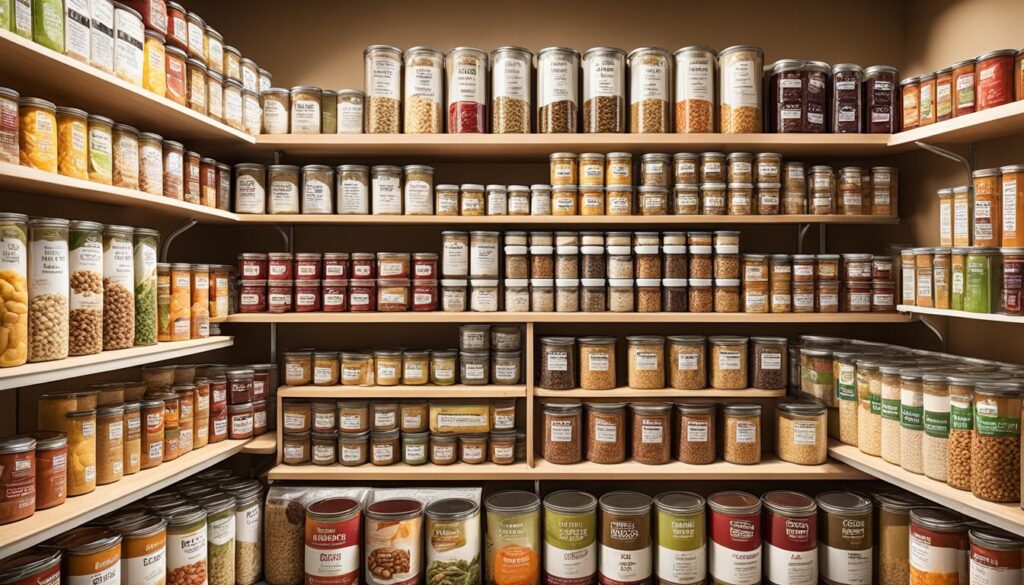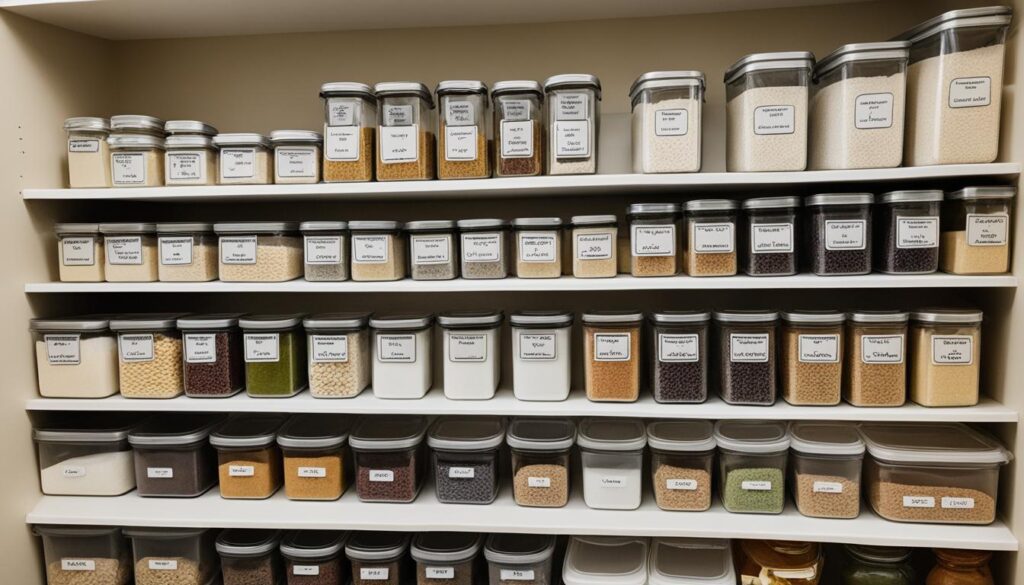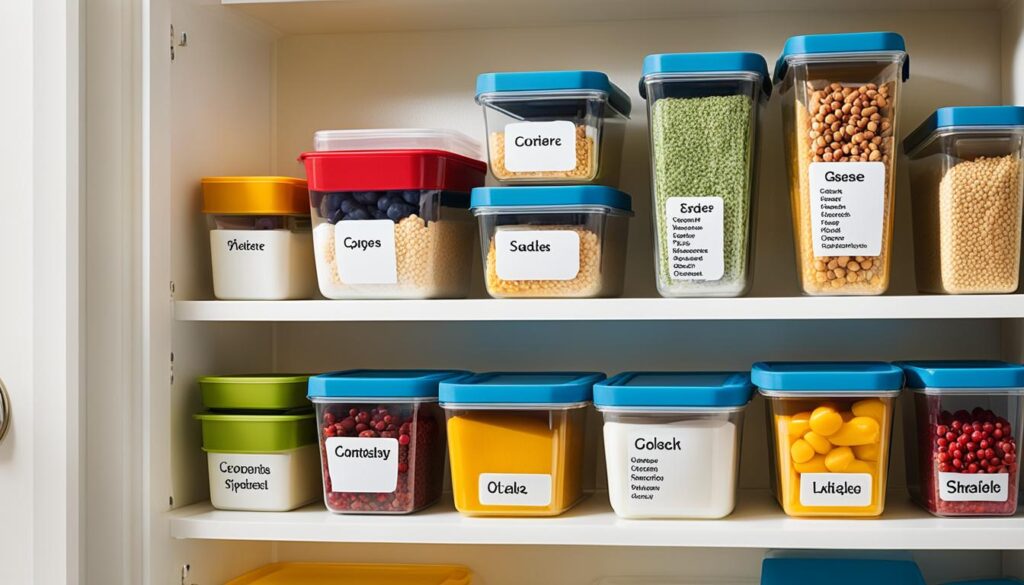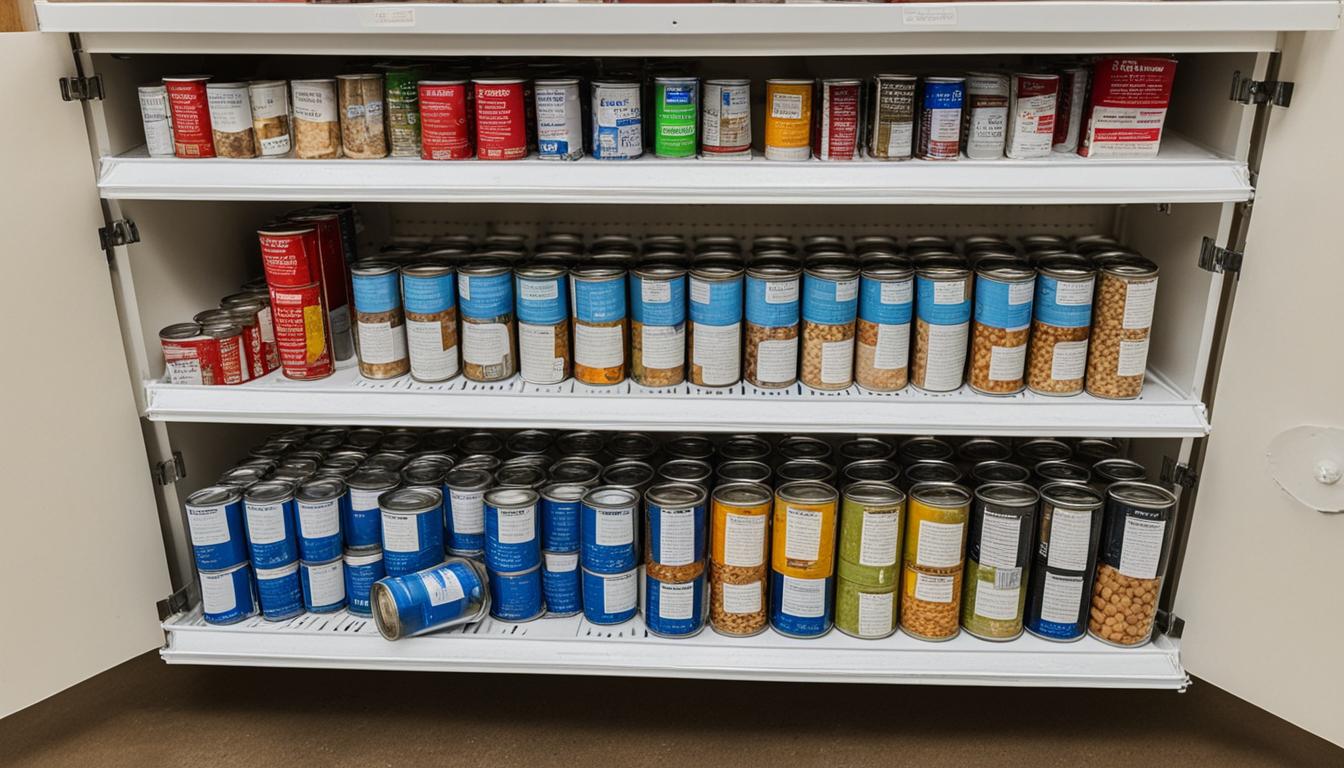“As an Amazon Associate I earn from qualifying purchases.”
Picture the moment when your life changes suddenly. An unexpected event throws your life into disarray, leaving you feeling vulnerable. No one wants to face this. That’s why having a plan for unexpected events is not just wise; it’s essential. Above just store beans and rice, building an emergency food supply is crucial. It’s about ensuring your family’s safety no matter the crisis, be it an earthquake or a hurricane.
Emergencies can happen at any time, requiring you to have a stocked food pantry. The Canned Food Alliance underlines that it’s vital to have nutrient-rich foods and plenty of water. It’s recommended to stock up on canned food and other essentials to cover your nutritional needs. Initially, aim for a three-day food kit and then increase to a one-month supply, especially for families. It’s important to think about special dietary needs for infants, the elderly, and those with allergies. And it’s crucial to remember to store food for your pets, too.
Expand your emergency food storage to include items like canned soups, trail mix, and instant pudding for variety and nutrition. It’s key to keep a variety of non-perishable foods and rotate them to avoid waste. By using trusted guidelines from Be Ready Utah and MyPlate.gov, you can ensure a balanced diet. Working towards a three-month supply helps you feel ready for whatever comes your way.
Key Takeaways
- A basic food storage supply should last for a minimum of one month, working towards a three-month supply.
- Start with a three-day supply in a disaster supply kit and expand as needed.
- Include special foods for vulnerable groups like the elderly and children.
- Remember to stock food for your pets.
- Diversify your emergency food storage for a balanced diet.
- Regularly rotate stored food to prevent wastage and maintain freshness.
- Look to reliable sources like MyPlate.gov for nutritional tips.
Why Emergency Food Storage is Essential
Understanding emergency food storage can be a lifesaver. It’s crucial to be ready for emergencies with a good food plan. Experts suggest keeping at least a month’s supply of non-perishable foods. Work towards a three-month supply. This way, you and your family can eat when normal food isn’t available.
Understanding the Importance
People need food to survive. You can only go without eating for three to four weeks. FEMA says each person should drink a gallon of water daily. This includes water for drinking, cooking, and washing. Make sure you have enough food stored for everyone to stay healthy.
Historical Context and Lessons Learned
In the past, people faced hunger from wars, natural disasters, and hard times. They learned the value of having extra food. Programs like MyPlate.gov show us how to prepare. They highlight the importance of different foods for good health.
This shows us that keeping a variety of foods is key to survival.
Modern-Day Scenarios
In our time, preparing for emergencies remains vital. Unfortunately, not many homes are ready with enough food. Only about 53% of households have a three-day food supply. It’s important to be aware and ready. Make sure your food storage meets the dietary needs of everyone, including pets.
Learn how to prepare and cook various types of food. This makes stored food last and keeps it nutritious.
| Food Type | Recommended Supply |
|---|---|
| Canned Proteins | Meats, Beans, Tuna |
| Fruits and Vegetables | Canned Fruits, Vegetables |
| Grains and Legumes | Rice, Pasta, Beans |
| Dairy | Powdered Milk |
Types of Non-Perishable Foods to Stockpile
Non-perishable foods are key for an emergency food stash. They stay good for a long time without chilling. This means you’ll have vital nutrition available when needed. Let’s explore what kinds of non-perishable foods you should gather:

- Canned Proteins: Gather canned tuna, chicken, and beef. They offer protein and last up to five years.
- Canned Vegetables and Fruits: Add canned veggies and fruits for vitamins and minerals.
- Grains: Have staples like rice, wheat, and oats. With 60 to 100 cans stored well, they’ll last up to 30 years.
- Legumes: Stock up on beans for protein and fiber. 12 to 15 cans are budget-friendly with a long shelf life.
Frozen-dried and dehydrated foods also offer great benefits:
- Freeze-Dried Foods: These keep for 25 years, retaining 97% of their nutrients and taste.
- Dehydrated Foods: They’re light, last long, and include fruits, veggies, and powdered eggs.
Add these non-perishable items for more food variety:
- Get a three-pack of Teddie All-Natural Super Chunky peanut butter for $32, costing only 36 cents per ounce.
- Pick a six-pack of Hint of Sea Salt Triscuits or Wheat Thins for $53, lasting longer thanks to vacuum sealing.
- Choose a six-pack of Nature Valley’s Variety Pack bars for $20, a quick 16-gram whole grain snack.
- Opt for a 12-pack of Safe Catch Elite Wild Tuna for $33.50, which has low mercury.
- Get a case of mixed vegetables from Libby’s for $31, ensuring varied vegetables for meals.
To keep your non-perishables nutritious and safe, check their dates every 6 to 12 months. Keep them in a cool, dry, and dark place in sealed containers. This preparation boosts your readiness and assurance for any crisis.
Balancing Nutrition in Your Emergency Food Storage
Making sure your emergency food supply has a balanced diet is key. It keeps you healthy, especially in tough times. Include foods from all the main groups like protein, carbs, vitamins, and minerals. This helps in the short and long term for your health goals.
Nutrient-Rich Food Groups
For a good emergency food supply, include a mix of foods. Items like canned veggies, fruits, and meats last a long time and offer needed vitamins and proteins. Grains including rice, pasta, and dry cereals give you the energy from carbs. Don’t forget nuts and seeds for healthy fats and options like powdered milk for calcium. These choices make your emergency food options better for you, keeping your diet in check.
MyPlate Recommendations
The MyPlate program guides us in what to have for a balanced diet. It recommends we stock up on veggies, fruits, grains, protein, and dairy. Mixing up each category well helps meet all our nutritional needs. For protein, try beans and for grains, have quinoa and oats. Lots of fruits and veggies, either canned or dried, will give us the vitamins and minerals we need.
Maintaining Health Under Stress
During emergencies, stress can harm us more if we don’t eat well. It’s especially important to keep a good mix of nutrients when we’re very stressed. Look to protein and complex carbs in foods like canned meats and grains for energy. Fruits and veggies, whether they’re dried or canned, give us the vitamins we need to stay healthy. Have these foods stocked and your meals will still be nutritious even in hard times.
- Plan for at least one well-balanced meal each day in your 2-week emergency food supply.
- Use a variety of food groups to maintain balanced nutrition under stress.
- Include nutrient-rich foods according to MyPlate recommendations to ensure complete nutritional coverage.
| Food Group | Examples | Purpose |
|---|---|---|
| Vegetables | Canned green beans, carrots | Vitamins and minerals |
| Fruits | Dried apricots, canned peaches | Fiber and vitamins |
| Grains | Rice, pasta, oats | Carbohydrates for energy |
| Protein Foods | Canned tuna, black beans | Protein for muscle maintenance |
| Dairy | Powdered milk, UHT milk | Calcium and vitamin D |
It’s very important to include these food groups in your emergency storage. By following MyPlate, you’ll keep a balanced diet when you need it most. This helps you stay well until regular food is available again.
Best Practices for Storing Food Long-Term
It’s important to keep your emergency food safe and fresh. Know the right ways to store your food for a long time. This includes keeping it at the right temperature, controlling humidity, and protecting it from pests.

Suitable Storage Locations
When thinking about storing food long-term, pick a good spot. Look for a place that’s cool, dark, and dry. Basements, closets, or any area out of direct sunlight are good. Don’t store food near things that give off heat, like stoves or heaters. This can make the food go bad faster.
Temperature and Humidity Control
Keeping the right temperature and humidity levels is key. Your storage area should be between 50°F and 70°F. Too much moisture causes mold and spoils food. Keep humidity below 60%. Use a dehumidifier if needed.
Protection from Pests
Pests can ruin your food storage. Always seal food containers tightly to keep bugs and rodents out. Use containers that pests can’t get into. Check your storage often for signs of bugs or rodents. If you see any, take action right away.
Follow these tips for storing food long-term to keep your emergency supplies safe. Make sure to keep the right temperature and humidity, and protect against pests. This way, your food will be ready when you need it.
Utilizing Preservation Techniques to Extend Shelf Life
It’s essential to know and use various food preservation methods for your emergency supplies. Canning, dehydration, and freeze-drying are key methods. They help keep your food safe and nutritious for a long time.
Canning
Canning is a proven way to store many types of food, like fruits, vegetables, and meats. You put the food in jars and heat it. This kills harmful microorganisms. The vacuum seal that forms keeps the food fresh by blocking out new bacteria.
Dehydration
Dehydration removes moisture from food. This stops bacteria, yeasts, and molds from growing. Dehydrated foods like fruits, veggies, and meats are lightweight and easy to store. When you need them, you can rehydrate them. They’ll taste and feel almost like fresh.
Freeze-Drying
Freeze-drying is a high-tech way to keep food from spoiling. It removes most of the water, preventing bacteria from growing. The best room temperatures for it are 45°–75°F. Depending on the food, it might need 24 to 48 hours to dry. With proper storage, freeze-dried foods last for years. You can use zip-top bags for short storage or vacuum packs for a few years. For the longest storage, Mylar® bags with oxygen absorbers are best. They use less space than glass jars.
Here’s a simple table to compare these preservation methods better.
| Preservation Method | Water Removal | Optimal Conditions | Shelf Life | Storage Options |
|---|---|---|---|---|
| Canning | Minimal | Cool, Dark | 1-5 years | Glass Jars, Metal Cans |
| Dehydration | 50-90% | Low Humidity | 1-2 years | Zip-Top Bags, Airtight Containers |
| Freeze-Drying | Up to 98% | 45°–75°F (7°–23°C) | 5-25 years | Mylar® Bags, Vacuum Packs |
Choosing the Right Containers for Food Storage
Choosing the right food storage containers is crucial. It helps keep your stored food safe for longer. The best containers protect from oxidation, keep away contaminants, and prevent moisture. This means your food stays nutritious and fresh over time.

Airtight Containers
Airtight containers keep foods like flour, rice, and pasta fresh. They block out moisture and air. This stops pests and cuts the chance of food spoilage. Glass containers are great for storing food for a long time. They keep food fresh and don’t absorb odors. Plastic containers are handy too. They’re light, tough, and affordable, fitting many storage needs.
Vacuum-Sealed Bags
Vacuum-sealed bags are perfect for dehydrated foods. They limit air exposure, preserving food texture and taste. Great for fruits, veggies, and meats. Whether in glass, plastic, or metal, these bags shield against moisture and oxygen. This keeps food fresh longer.
Food-Grade Buckets
Food-grade buckets are best for big supplies like grains and legumes. They come in various sizes. For example, a 5-gallon bucket can hold up to 35 lbs of sugar or 37 lbs of wheat. Sealing them with gamma lids keeps them air and water-tight, warding off contamination.
Metal containers are also durable. They offer protection against rust and pests. Stay away from non-food grade plastics. They might put chemicals into your food. Don’t reuse containers if you don’t know what was in them before or if they weren’t for food. This stops contamination.
Benefits of Shelf-Stable Provisions
Shelf-stable provisions are key to a long-term food supply. They don’t need refrigeration to stay usable. This category includes canned goods, grains, dehydrated foods, and powdered milk. They are made to last, reduce waste, and save money.
Emergency experts recommend having a seven-day supply during crises. For example, canned goods stay safe to eat for two to five years. Freeze-dried foods are good even after 25 years. This long life means food is available when it’s most needed.
These items meet daily calorie needs, too. An average person should eat between 2000 to 2400 calories. Emergency food bars provide 1200 calories a day, fitting for short crises.
Keeping them in the right place helps. Store in cool, dry, and dark spots. This keeps the food from spoiling. It makes them dependable for unexpected events or times of need. Shelf-stable items are a smart and budget-friendly choice.
Creating a Food Rotation System
Having a good food rotation system is key to managing your emergency food. It keeps food fresh and safe to eat. Plus, it helps prevent food wastage. Let’s look at some ways to make a great system.
First In, First Out (FIFO) Method
FIFO is a top method for food rotation. It means you eat the older food first. This keeps your food supply fresh. When you get new food, put it where the old food was. This method is perfect for keeping your emergency food ready to go.
Tracking Expiration Dates
It’s crucial to keep up with expiration dates on your emergency food. Use label makers to mark each item with its name and expiration date. They’re better than markers because labels stay clear longer. Writing down expiration dates in a list or spreadsheet is also helpful. This keeps you from forgetting and avoids food spoilage.
Avoiding Food Waste
A good food rotation system and keeping track of dates cut down on food waste. Sort your food by type or nutrition value to keep organized. Know the shelf life of each item and how to tell when it’s gone bad. For example, transferring freeze-dried veggies to airtight bags can help them last longer.
Storing food in the best conditions is important too. This means keeping it at the right temperature and away from sunlight. Also, make sure you have enough space. These steps help maintain the quality of your food stash.
It’s also smart to keep food in various places in your home. Spread out foods that last a long time, like freeze-dried options. This way, if one location is hit by a disaster, you still have other places safe.
For a more detailed plan on rotating your food supply, check out tips from experts. They can offer more advice for better food planning.
Essential Foods for a Balanced Emergency Diet
It’s key to have a balanced emergency diet. This ensures you and your family get the right nutrients in a crisis. Make sure to stock up on protein sources, carbs and fiber, and fruits and veggies. This will help keep you healthy during hard times.
Protein Sources
Protein helps with muscle upkeep and repair. Go for long-lasting canned meats like Safe Catch Elite Wild Tuna, which is $33.50 for six on amazon.com. Peanut butter is another good choice, at $32 for a three-pack on amazon.com. It’s also a great energy source. Nature Valley’s Variety Pack granola bars, costing $20, are a handy option for protein.
Carbohydrates and Fiber
Carbs and fiber provide energy. Look for crackers like Hint of Sea Salt Triscuits or Wheat Thins. They’re $53 for a six-pack on amazon.com and stay fresh in vacuum packs. Pasta, including gluten-free and chickpea pasta, is good for different diets and lasts a long time. Adding these to your emergency stash will help keep your diet balanced.
Fruits and Vegetables
Fruits and veggies are packed with essential vitamins and minerals. Dried fruits by Crispy Fruit, at $20 on amazon.com, give you potassium and fiber. Cans of Libby’s mixed vegetables, $31 on amazon.com, contain a mix of healthy veggies. Having both canned and dried options boosts the health benefits of your emergency diet.
FAQ
How much food and water should I store for emergency preparedness?
What types of foods are ideal for long-term food storage?
Why is it important to have a balanced diet in an emergency food supply?
Where should I store my emergency food to ensure it stays fresh?
What preservation techniques can I utilize to extend the shelf life of my emergency food supply?
How should I store different types of food to ensure their longevity?
What are the benefits of shelf-stable provisions?
How can I manage my emergency food supply effectively?
What essential foods should I include in my emergency diet to ensure proper nutrition?
Source Links
- https://beready.utah.gov/family-preparedness/12-areas-of-preparedness/food/
- https://www.readyproject.com/blogs/emergency-food-storage-and-survival-tips/the-importance-of-emergency-food-storage
- https://www.idyllicpursuit.com/survival-foods-for-emergencies/
- https://www.realsimple.com/food-recipes/shopping-storing/emergency-foods
- https://theprepared.com/homestead/guides/supermarket-food-list/
- https://extension.umn.edu/how-prepare/preparing-2-week-emergency-food-supply
- https://blogs.cdc.gov/publichealthmatters/2022/03/nutrition/
- http://www.readyatlantic.org/prepare/emergfoodwater.asp
- https://extension.psu.edu/lets-preserve-freeze-drying
- https://www.survivalfoodkits.co/blogs/survival-food/long-term-food-storage-containers
- https://thesurvivalmom.com/food-storage-containers/
- https://llu.edu/campus-spiritual-life/emergency/emergency-food
- https://queal.com/ps/long-shelf-life-food
- https://www.safecastle.com/blogs/safecastle-blog/benefits-of-long-shelf-life-foods-a-comprehensive-guide
- https://www.beprepared.com/blogs/articles/spring-cleaning-rotate-food-supply
“As an Amazon Associate I earn from qualifying purchases.”

